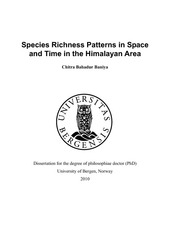| dc.contributor.author | Baniya, Chitra Bahadur | eng |
| dc.date.accessioned | 2010-04-07T13:19:38Z | |
| dc.date.available | 2010-04-07T13:19:38Z | |
| dc.date.issued | 2010-02-19 | eng |
| dc.identifier.isbn | 978-82-308-0972-3 (print version) | en_US |
| dc.identifier.uri | https://hdl.handle.net/1956/3861 | |
| dc.description.abstract | Aims: The Himalayan Mountains are highly sensitive to current global climate changes and their local impacts. Potentially more sensitive are lichens growing throughout the Himalaya and species living in the alpine zones of the world. In this synthesis I examine the variation in species composition and richness patterns at different scales of spatio-temporal gradients from mountainous areas in the Tibet Autonomous Region (TAR) and the Nepalese Himalaya. Methods: This thesis is based on field-survey data as well as secondary data from published floras. The study of the temporal responses of plant species composition, richness and soil heterogeneity is based on direct field sampling in old abandoned fields forming different chronosequences in the trans-Himalayan zone, Nepal. Likewise, the elevational response of species composition, richness patterns and soil nutrient heterogeneity are investigated by direct field observations and sampling in Buddha Mountain, Nyenchentanglha Shan, Central Tibet, TAR. Buddha Mountain elevation gradient study is compared with similar species but based on secondary data, namely published floras over almost a similar elevational range. The elevation gradient of lichen species in Nepal has been studied based on published literature on Nepalese lichens. Major findings: (i) Lichens, both in TAR, on Buddha Mountain and in the Nepalese Himalaya represent the organism group with the highest elevational occurrences and a high degree of adaptations to extreme environments. A unimodal elevational relationship is common in lichen species richness. Maximum richness for Nepalese endemic lichens coincides with the maximum elevation range for Nepalese vascular plant endemics. (ii) Landscape-level elevational species richness patterns (Buddha Mountain) show an early plateau and a sharp decline afterwards that differs from the smooth decling pattern with the interpolated macro-scale elevational ranges. This may indicate that differences in scale of the measurement of species, averaging out of environmental heterogeneities and the influence of climatic variables increasing with increasing spatial scales are all potentially important. (iii) The general pattern for the total richness hides a variety of specific patterns for the subgroups of life-forms and substrate types considered. (iv) A divergence pattern of secondary succession is indicated after increasing beta diversity along the temporal gradient in the trans-Himalayan zone. But the total species richness clearly indicated a unimodal species richness pattern in the secondary succession. Decreased richness with increased beta diversity towards the oldest abandoned fields highlights the potential importance of the high intensity of grazing, and grazing-tolerant ‘nurse’ species protecting future forest species. Conclusions: Species richness and composition patterns are highly scale dependent at all levels of spatio-temporal gradients. Scales at all hierarchical levels are inter-related. Some variables such as soil-related local-scale heterogeneity are highly important at the local-scale species composition and richness patterns. But that type of variables will not be significant or will be averaged out at a broader scale. Climate-related variables are highly influential at the broad-scale but can also be influential at local scales. Species richness patterns depend on the studied group of species, functional group of species, life-forms and their geography. The ecological significance of species depends on elevation. For example, in Nepal an elevation of 500 m is suitable for big wild animals, likewise 1000 m for vascular plants and 3100 to 3400 m for lichens. This indicates an important conservation strategy. Implications: Further investigation on elevational and temporal species richness patterns in other landscapes of both Tibet and Nepal Himalaya will extend the findings of the present study and help to predict the local impact of broad-scale climate change on the biodiversity hotspots of the Himalaya. | en_US |
| dc.language.iso | eng | eng |
| dc.publisher | The University of Bergen | en_US |
| dc.relation.haspart | Paper I: Baniya, C. B.; Solhøy, T.; Gauslaa, Y.; Palmer, M. W., 2010, Richness and Composition of Vascular Plants and Cryptogams along a High Elevational Gradient on Buddha Mountain, Central Tibet. Full text not available in BORA. | en_US |
| dc.relation.haspart | Paper II: Baniya, C. B., 2010, Vascular and cryptogam richness in the world’s highest alpine zone, Tibet. Full text not available in BORA. | en_US |
| dc.relation.haspart | Paper III: The Lichenologist 42(1), Baniya, C. B.; Solhøy, T.; Gauslaa, Y.; Palmer, M. W., The elevation gradient of lichen species richness in Nepal, pp. 83-96. Copyright 2009 British Lichen Society. Published by Cambridge University Press. Full text not available in BORA due to publisher restrictions. The published version is available at: <a href="http://dx.doi.org/10.1017/S0024282909008627" target="_blank"> http://dx.doi.org/10.1017/S0024282909008627</a> | en_US |
| dc.relation.haspart | Paper IV: Plant Ecology 201(2), Baniya, C. B.; Solhøy, T.; Vetaas, O. R., Temporal changes in species diversity and composition in abandoned fields in a trans-Himalayan landscape, Nepal, pp. 383-399. Copyright 2008 Springer Science+Business Media B.V. Full text not available in BORA due to publisher restrictions. The published version is available at:<a href="http://dx.doi.org/10.1007/s11258-008-9473-3" target="_blank">http://dx.doi.org/10.1007/s11258-008-9473-3</a> | en_US |
| dc.rights | All rights reserved | eng |
| dc.subject | Species richness | eng |
| dc.subject | Lichen | eng |
| dc.subject | Elevation gradient | eng |
| dc.subject | Nepal | eng |
| dc.subject | Himalaya | eng |
| dc.subject | Tibet | eng |
| dc.title | Species Richness Patterns in Space and Time in the Himalayan Area | en_US |
| dc.type | Doctoral thesis | |
| dc.rights.holder | Chitra Bahadur Baniya | en_US |
| dc.rights.holder | All rights reserved | en_US |
| dc.subject.nsi | VDP::Matematikk og Naturvitenskap: 400::Zoologiske og botaniske fag: 480 | nob |
